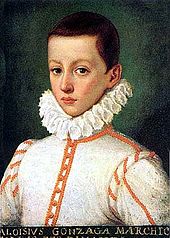On this 21st day of June, we remember Saint Aloysius Gonzaga (+ 1591), a Jesuit scholastic who died at what we might consider the too-young age of 23 (just short of the 24 club, but an honorary member) while solicitously caring for victims of the plague in Rome. But he accomplished much in a short time.
Aloysius, whose original name was Luigi, hailed from a rich, noble family, and was intended for a life of honour and privilege. In spite of his parents’ and relatives’ urgings, he began to distance himself from their intended end for him, even while a young boy. Soon after receiving his First Communion from Saint Charles Borromeo, he took a private vow of chastity when he turned nine, and adopted a life of strict asceticism. Later in his teen years, against his father’s wishes (who finally relented), Aloysius firmly and unequivocally decided to enter the Jesuits, renouncing all rights to his significant inheritance. He was the ‘rich young man’ who did not turn away sorrowful, but followed Christ, full of joy, giving all.
As a novice, Aloysius’ spiritual director was none other than Saint Robert Bellarmine (saints forming saints!), a fellow Jesuit and a Cardinal, one of the great lights of the post-Tridentine reform and renewal. It was Bellarmine who would later offer sage advice to Galileo, and may have been able to avert that crisis and debacle, had he lived long enough. But guiding a young novice to holiness is no small feat in itself. Aloysius once admitted to his director that the smell and uncleanness of the plague victims made him violently sick, a repugnance that he suppressed so well that no one ever suspected, his zeal for the unenviable task seemed so evident to those around him. Aloysius was well aware of his own potential for sin and vice, in which so many around him were immersed, once admitting, I am but a crooked piece of iron, and have come into religion to be made straight by the hammer of mortification and penance.
We might also add, by the grace of the good God. For holiness is primarily His work, with our cooperation. Such penance as we do simply removes the obstacles to what God Himself wills to do within us. Holiness is also interior, consisting in conforming our own will to God’s, even in the smallest things. As Saint Philip Neri, who died four years after Aloysius (but six decades older) once quipped: ‘Sanctity resides in the space of three fingers’, in the mortifactione rationale, the mortification of our reason, and submitting our minds and wills to God, through holy obedience.
But we should ponder, if such an endeavour cost Aloysius so much, what should it cost us? Christ warns us of the ‘wide and easy path’ to perdition, and exhorts us to choose the ‘narrow and hard’ way to salvation. Following that in youth is much easier than trying to find it in late middle age, even if all things are possible to God.
We know not what the idealistic and inspired soul of Aloysius might have done in a life long lived. But such was not to be, for, like any number of other saints, Pier Giorgio, Dominic Savio, Therese of Lisieux, he was snatched up to heaven young, his soul already purified, which is what life is about, really: to reach that potential of sanctity to which we are all called. Aloysius offers a very fitting example to the youth of today, immersed in ‘sins of the flesh’, impurity and all those vices contra naturam, like no other generation perhaps in history, the ubiquitous ‘smartphones’ too often a portal into the depths of Dante’s inferno, and Satan’s own portal into their young souls. Would that they used those same devices to read the lives of the saints!
The mystic Maria Magdalena de Pazzi (May 25th) had a vision of the saint on April 4, 1600, a decade after his death, wherein it was revealed to her that he had died an ‘interior martyr’, and is now known primarily for his virtue of purity, integrating his affective powers – those ‘bent pieces of iron’ – towards that love of God which in the end is the source and summit of all our loves. As Aloysius once wrote to his mother:
When He takes away what He once lent us, His purpose is to store our treasure elsewhere, more safely and bestow on us, those very blessings, that we ourselves would most choose to have.
Saint Aloysius was taken away from his mother soon afterward, dying on this day, the 21st of June in 1591, of the illness he had contracted from the patients for whom he was caring – a death he himself prophesied. He was canonized on December 31st, 1736 by Pope Benedict XIII.
As his Collect for today says, let those of us who have not followed his innocence, at least follow his path of penitence and conversion in the time that remains to us.
This is the first full day of summer, the longest day of the year (in the northern hemisphere), solstice marking the Earth’s bending its own curve through space and time in its midway point in its 186 million mile journey around the Sun, in whose health-giving warmth and light, a symbol of that eternal Light, we may rejoice.
Saint Aloysius Gonzaga, ora pro nobis! +












